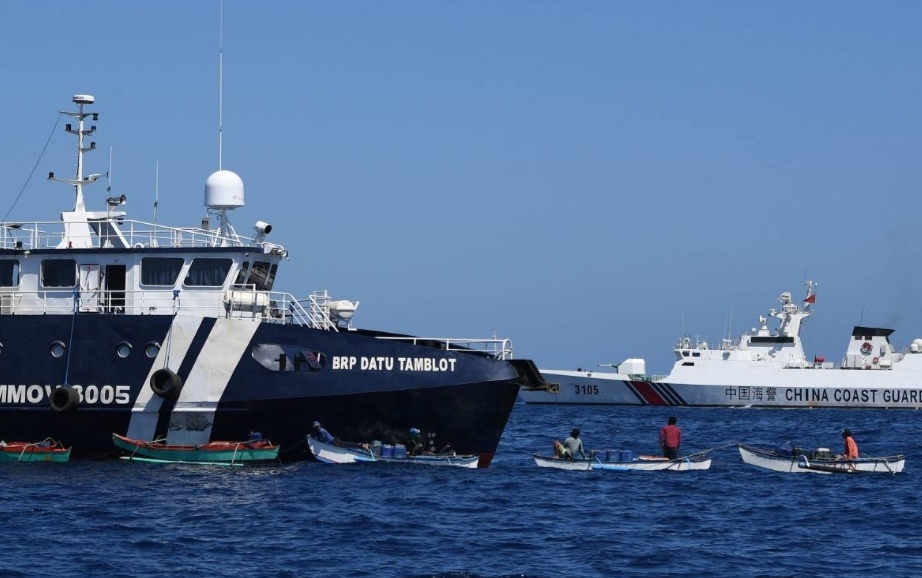Stay put in disputed waters orders President Marcos to Cost Guard
PRESIDENT Ferdinand Marcos Jr. ordered the Philippine Coast Guard (PCG) to continue its rotational deployment of ships in the West Philippine Sea in a move that “does not intend to provoke anybody” but will merely ensure that Filipino fishers are protected against China’s harassment and incursions.
The President’s order comes as Chinese vessels moved to block access to Ayungin (Second Thomas) Shoal on Saturday morning as Philippine ships conducted another Rotation and Resupply (RoRe) mission to Filipino troops stationed on board BRP Sierra Madre.

Before Saturday’s incident, Raymond Powell, a retired United States Air Force colonel and founder and director of SeaLight, a maritime transparency project monitoring and reporting South China Sea activities, lauded the President’s policies in dealing with Beijing and its aggressive actions in the contested waterway.
“The Marcos administration has certainly shown a lot of courage. It is not easy for a country of 125 million to take on a country of 1.4 billion, a rising power with nuclear weapons,” Powell, a former defense attaché of the US government to Vietnam and Australia, recently told The Manila Times.
“That’s not easy; that takes what we call intestinal fortitude. It takes guts, and I’ve certainly been impressed with the Marcos administration and its willingness to risk escalation for the sake of asserting its (the Philippines’) sovereignty,” he added.
In a Saturday news forum in Quezon City, PCG spokesman for WPS Jay Tarriela dismissed comments that the Philippines was provoking China or escalating tension in the WPS with the rotational deployment of vessels by the PCG and Bureau of Fisheries and Aquatic Resources (BFAR) in Bajo de Masinloc or the Scarborough Shoal where Chinese ships were reported to have driven away Filipino fishermen. This has since been denied by the government.
“You know, their presence, with or without the government vessels’ rotational deployment of PCG and BFAR vessels in Bajo de Masinloc, they were there,” Tarriela told reporters.
“Our objective here is not to provoke anybody, not to escalate the tension in Bajo de Masinloc. Our objective here is to protect the Filipino fishermen, to make sure the Filipino fishermen will be able to fish in Bajo de Masinloc,” he added.
Tarriela said that the guidance of the President is very clear — “to have a rational deployment between the Philippine Coast Guard and the Bureau of Fisheries and Aquatic Resources to maintain our presence in Bajo de Masinloc.”
He said the PCG had maintained its presence in Philippine waters from February 1 to 9 while the BFAR deployed its personnel after their shift in the rotational deployment.
Tarriela also said the BFAR had deployed its BRP Datu Tamblot, or the MMOV-3005 and the Cessna Caravan, the RP-1077, and the Cessna 208-B and its aircraft that came from Clark, Pampanga.
“The guidance of the President has been very clear. The rotational deployment will be here to stay between the Philippine Coast Guard and the Bureau of Fisheries and Aquatic Resources,” the PCG official said.
“The objective of which is also related to the first question — for the food security, to make sure that we’re going to protect the Filipino fishermen’s rights and to ensure that the Filipino fishermen will go their fishing freely without any harassment,” he added.
During its latest patrol, Tarriela said the PCG continues to experience “dangerous maritime maneuvers” from Chinese vessels in the WPS.
He said they had monitored four China Coast Guard (CCG) vessels and a People’s Liberation Army (PLA) Navy vessel.
Tarriela said the vessels identified as CCG 3063 and 3064 have been deployed in the area to make sure that the southeast entrance of Bajo de Masinloc is well-guarded by putting floating barriers every time they monitored Philippine vessels nearby.
He added that they monitored CCG 3302 and 3105, carrying out “dangerous maneuvers” to prevent the BFAR and PCG vessels from getting near Bajo de Masinloc.
Meanwhile, BFAR said it has successfully provided assistance and provisions to Filipino fishermen in Bajo de Masinloc.
During the same Saturday’s new forum, BFAR spokesman Naz Briguera said the resupply mission of the BFAR and the PCG to Filipino fishermen in Bajo de Masinloc is aligned with the vision of the “Bagong Pilipinas” ensuring food security.
“It’s not just about the volume of fisheries production, but it’s about the importance of the West Philippine Sea in maintaining the integrity of our marine resources,” Briguera said.
Another Chinese blockade in Ayungin
Meanwhile, several Chinese vessels were seen blocking the Philippine ships on resupply missions to the BRP Sierra Madre.
Powell said a China Coast Guard vessel with bow number 5203 and two Chinese maritime militia (CMM) ships moved to block access to Ayungin as PCG ships BRP Cabra and Sindangan passed south of the shoal and nearby Mischief (Panganiban) Reef.
This latest blockade by China in Ayungin Shoal comes two days after the incident in Bajo de Masinloc, where the CCG claimed to have “implemented measures to control the [Philippine] vessel’s navigation and compel it to leave the area in accordance with law” and that the situation was handled in a “professional and standardized manner on-site.”
‘Assertive transparency’
Powell said the country’s unceasing filing of diplomatic protests and publication of photos and reports of harassment incidents of the CCG and CMM are examples of the government’s “assertive transparency” as this sheds light on what China has been doing in the shadows.
He cited the Feb. 6, 2023 incident at the Ayungin Shoal when a CCG ship used a military-grade laser to drive away a Philippine Coast Guard vessel.
Documentation of the incident made by the PCG was released, a move that Beijing obviously was displeased about as this garnered more international attention, which led to more support coming the way of the Philippines.
“The Philippines discovered something that it could use as leverage in the struggle,” Powell said.
“The Philippines is obviously overmatched by the strength of the CCG and Chinese maritime militia ships, but what it did have was essentially a moral high ground,” he added.
Said “braver” front of the Philippines has certainly erased the “false dichotomy” presented by the past leadership of Rodrigo Duterte, who was perceived to have a “pro-China” policy, Powell asserted.
“I think President Duterte, in evaluating the situation in the West Philippine Sea, said, ‘We don’t want to go to war with China.’ Well, nobody says you have to go to war with China. What was made was a false dichotomy, a false choice — either submit or have peace or contest and have war,” he said.
“But that’s not the way it works. It’s not like an on-and-off switch. There are many different ways you can approach it, and if submission is your only option, then all you’d find out is that your adversary will take advantage of you,” he added.
Marcos has reiterated numerous times that the Philippines “will not give up a single square inch of our territory to any foreign power” and that under his watch, the country would fully and unrelentingly assert its sovereignty in adherence “to the lawful exercise of rights under international law demonstrates the strength of the alliances.”
“Supported by the rules-based international order and our growing partnerships, both time-tested and new ones, we will insist on the preservation of the sovereignty and integrity of the country while working closely with international partners in the bilateral, regional, and multilateral settings in developing rules and processes to address these challenges,” the President said.




